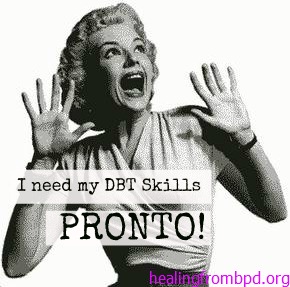-
Levels of Validation
This www.dbtselfhelp.com site has much more information that I thought at first. I went to the site map and found a ton more stuff burried under the navigation. Here’s one good snippet on validation: When a person confides in you, they are not usually looking for advice or problem-solving unless they specifically ask for it. Rather, they are looking for validation. If you are not used to validating, here are some suggestions. There is no greater way to set a person at ease. Level One Overall show interest in the other person (through verbal, nonverbal cues), show that you are paying attention (nodding, eye contact, etc.) Ask questions – “What…
-
Are you pissed off at someone with BPD?
UPDATE 10/2008: This post is quite old… but it still applies. However, if you want to know HOW to do some of the things I mention here, I have recently published the I-AM-MAD communication skill, which distills one of the main skills that I present in my book, When Hope is Not Enough. Hi all. I have been monitoring the “non” email lists and have found a common idea that I believe is a misconception about borderlines. A taste of this idea can be seen in this paraphrased comment: “When will my BP be willing to take responsibility for his/her actions? When will he/she try and fix the harm he/she has…
-
Invalidating Phrases
I found this list of invalidating phrases on another site. I think we nons can learn a lot from this list. Invalidation is weird – and it is a natural reaction to what we think is “crazy” behavior and feelings: “Ordering” the BP to Feel Differently Smile. Be happy. Cheer up Lighten up. Get over it. Grow up Get a life Don’t cry. Don’t worry. Don’t be sad. Stop whining Stop laughing.. Don’t get angry Deal with it. Give it a rest. Forget about it. Stop complaining. Don’t be so dramatic. Don’t be so sensitive. Stop being so emotional. Stop feeling sorry for yourself Stop taking everything so personally Ordering…
-
Validation and DBT
Validation and DBT: Validation in DBT involves five different levels. This first two are similar to other psychotherapies and involve unbiased listening and observing, and eliciting and accurately reflecting the patient’s thoughts, feelings, and assumptions. The third step of validation is to articulate for the patient unverbalized emotions, thoughts, or behavior patterns. The idea is to accurately “read their minds” and help them learn to accurately label internal states. The fourth step is for the therapist to validate the person’s present behavior based on their past learning history. In other words, from the DBT perspective, any human given the same biological makeup and learning history would end up responding in…
-
More on Validation and DBT
Validation and DBT: Validation in DBT involves five different levels. This first two are similar to other psychotherapies and involve unbiased listening and observing, and eliciting and accurately reflecting the patient’s thoughts, feelings, and assumptions. The third step of validation is to articulate for the patient unverbalized emotions, thoughts, or behavior patterns. The idea is to accurately “”read their minds”” and help them learn to accurately label internal states. The fourth step is for the therapist to validate the person’s present behavior based on their past learning history. In other words, from the DBT perspective, any human given the same biological makeup and learning history would end up responding in…
-
Invalidating Environments
Invalidating Environments Although there are many examples of invalidating environments, all share three characteristics: (1) individual behaviors and communications are rejected as invalid; (2) emotional displays and painful behaviors are met with punishment that is erratically administered and intermittently reinforcing; (3) the environment oversimplifies the ease with which problems may be solved and needs met. Most of us have encountered such environments at some point in our lives and we commonly deal with them by changing our behavior to meet expectations, or by changing the environment so that it is no longer invalidating, or, ultimately, by simply leaving the environment. The dilemma for the borderline patient occurs when the individual…




